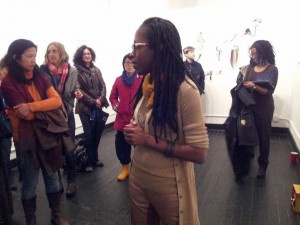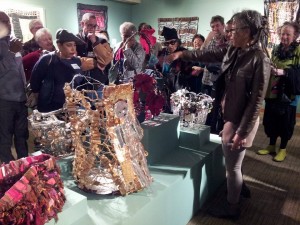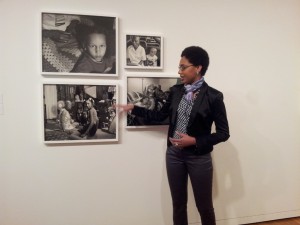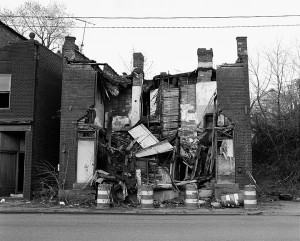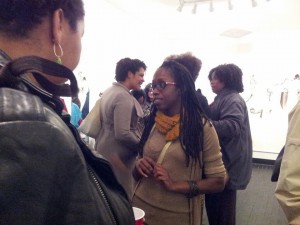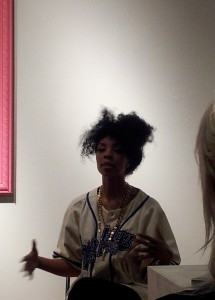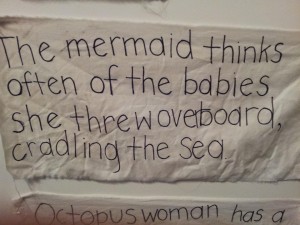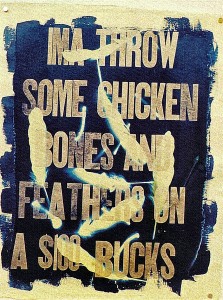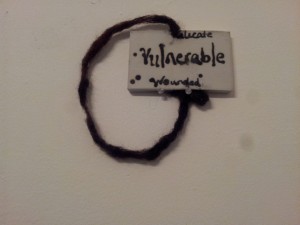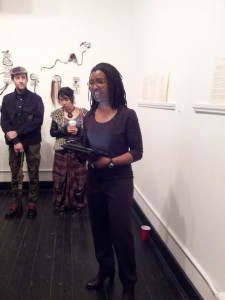The Elephant in the Room: “Stereotype” and other exhibitions by African American Artists in Seattle
The exhibition “Stereotype” curated by C. Davida Ingram at the LxWxH gallery offers a highly conceptual contribution to the several fascinating exhibitions by African American artists currently on view in Seattle. At the Northwest African American Museum in addition to “Pitch Black: African American Baseball in Washington State,” there is also “Marita Dingus: At Home” a selection by the artist of some of the contents of her home, re-installed at the museum. Dingus creates aesthetic objects out of trash, objects which often again become useful. At Photo Center NW “Seen: An Exploration of the Inside and the Out, the Then and the Now, By the (Still) Invisible Man,” included photographs by 25 men (and boys) of African descent in Seattle. ( It closed in early March.) As part of the exhibition at Photo Center NW was a projection from the online video project “Question Bridge: Black Males” still visible on line ( link below).
Jacob Lawrence and Gwendolyn Knight Prize winner LaToya Ruby Frazier has an exhibition of her photographs with the title “LaToya Ruby Frazier: Born by a River,” on display at the Seattle Art Museum until June 22.
Marita Dingus’ extraordinary art reclaims materials and transforms them into both useful and aesthetic formats. Her exuberant style and amazing eye for the potential in any material is a profound act of reclamation.
In “Seen,” curated by Maikoiyo Alley-Barnes, with Michelle Dunn Marsh and Ann Pallesen of PCNW the photographs ranged from traditional format black and white images to informal polaroids and small snapshots, most of them from the personal lives of the photographers who ranged in age from very very young to old. At the opening, most of the photographers were there, and we could talk to them about their work and what it meant. It was a rare opportunity for dialogue across the “color line” in a non-confrontational atmosphere. “Question Bridge: Black Males”
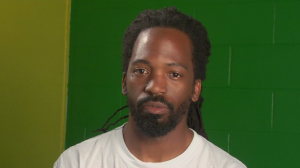
is an ongoing video project that according to the website “explores critically challenging issues within the African American male community by instigating a trans-media conversation among black men across the geographic, economic, generational, educational and social strata of American society. “ Question Bridge” provides a safe setting for necessary, honest expression and healing dialogue on themes that divide, unite and puzzle black males today in the United States. “Question Bridge: Black Males” was created by Chris Johnson, Hank Willis Thomas, Bayeté Ross-Smith, and Kamal Sinclair.”
In contrast to the informality of the photographs in “Seen” and the talking heads videos of “Question Bridge,” as well as their multiple perspective and historical places, La Toya Ruby Frazier’s photographs are straight forward statements about a specific place, issue, and idea.
The first part of the exhibition is a series of black and white about her family:the second half are large aerial view color photographs (as her career has grown increasingly successful, she has been able to do large format aerial photography). Photographing in Braddock, Pennsylvania, where the first and last Carnegie Steel Mill operates, Frazier documents both the intimate acts of caring by people, here her grandmother, inside the houses of African Americans who could not afford to move away from the toxic environment near the steel mill, and the view of the deterioration and gentrification of what is still a community being destroyed in the early 21st century by neoliberal capitalism. LaToya Ruby Frazier provides a direct statement about racism and the toxins of both industry and gentrification.You can read my longer review of her work here (scroll down).
As an aside here, I have to add that Sandra Jackson-Dumont who has curated all three of these Gwendolyn Knight and Jacob Lawrence awards, as well as wonderful education programming, has done a brilliant job. She is now going to the Metropolitan Museum of Art in New York City and will leave a big vacuum where she has been in our community.
“Stereotype,” in contrast to these exhibitions, is text based: it explores the concept of “stereotype,” by artist/poets who combine in your face statements, and metaphors that slip away from being clearly understood. Of course, a stereotype is something everyone thinks they understand: labelling, a shallow cliché. The bold type in the title is Davida’s own initial slipping us away from knowing. She refers to the original meaning as a “relief printing plate,” then moves on to “perhaps something as onerous as a stereotype can be overcoded, remade, and straight up appropriated. “ That pretty much sums up what is purposefully explored in this show.
At the opening, of “Stereotype,” the room was filled with smart artists and poets of all ages and colors. Although planned since October by Davida and Sharon Arnold, curator of the gallery, the exhibition was a perfect expansion of the “Seattle Women’s Convention.” Davida was among about three women of color who attended the “Women’s Convention” event in the winter (still going on Facebook and subsequent gatherings). It consisted of a large number of mostly white, mostly young women gathering in the Hedreen Gallery at Seattle University to discuss “feminism” a term they were mostly afraid of having as an identification.
They met in front of a huge painting of famous slave owner Andrew Jackson wearing a pink dog collar by Tariqa Waters (an African American artist who eventually was invited to join the discussion up front); here she is explaining her painting , where it hung for one night. A recent arrival in Seattle, she has a dynamic style all her own. Here is an interview with her.
I had not met Tariqa before, but C.Davida Ingram, Sandra Jackson-Dumont, Barbara Earl Thomas, these are women who constantly appear at the dominantly white art events in town, negotiating through them with finesse, grace and subtlety.
So it was about time to be at an event where the exhibition was all women of color, with a theme like “Stereotype.” Now, one can ask, why all black women? White women get stereotyped too! But the fact of black women commenting on stereotyping had coherence and depth that would have been less emphatic in a mixed show.
So for me as a white person, what did I understand in the show? I felt that I was negotiating with another culture, I was navigating black culture with some markers that were easy to understand (stereotypes). White becomes the Other here, slipping off the preconceived ideas of our stereotypes and clichés .
What was Davida saying, what were the other artists saying?
First of all, text was the primary assignment to the artists, so there was a lot of reading. But the first element was a video, directly in front of the door, called, appropriately enough, “The Elephant in the Room.” It had two parts, in one part an elephant who attacked some people is shot, in the second part an elephant is released to be reunited with his mate after many years. The video was captioned, and at the moment of release, the zoo tender says “there’d be no more chains.”
That is the frame reproduced in the catalog, just in case we didn’t get the point here. Obviously the metaphor is about the “other,” racism, race. But Davida slips us along and expands that obvious statement, by declaring the elephant is “many things, especially narrative itself ( ie who gets to tell the story and how.)”
Near the video is Barbara Earl Thomas’s art work and texts. Davida referred to her as the matriarch/goddess in her introduction. Indeed, that is one of the great contrasts with the
“Women’s Convention.” C. Davida Ingram honors and builds on the older generation. She knows them and loves them. Among the (white) women who discussed feminism in February, although a matriarch/guerrilla girl dramatically revealed herself, the young women seemed to still be adrift in an isolating fear of the idea of feminism.
After the grounding of Barbara Earl Thomas’s texts, easy to understand and follow about childhood incidents of race, I moved on to the work of francine j. harris. Two mirrors, one with white writing, the other with black writing, listed definitions for the many terms for different colors of skin among people of African descent. Francine j. harris is a poet. The work called “hon*ey” included about 18 different colors, like caramel, cocoa, chocolate, with “definitions” of those terms that appear to be random. Appropriately, we could barely read the texts, they flickered in and out of vision because they were written on mirrors. The reproduction in the catalog likewise is virtually camouflaged by reflections. One detail is visible: caramel” 1. A company of travelers journeying together as across a desert…. 4. Naut. Any of several types of small light sailing ships, esp one with two or three masts . . . used by the Spanish and Portuguese in the 15th and 16th centuries. “ So here are references to the slave trade, in this definition of caramel, which is, of course a type of candy; that definition is never mentioned. So here I am challenged, in and out of understanding.
Another work by Davida written on sheets, “Conjures and the Mermaid” consists of 14 segments. On each square of sheet are small phrases that sound like story fragments. Sometimes they are funny in a nonsense way, but then we get the thrust (literal and metaphorical) “I’m sorry my dragon ate your dog,” the mermaid said as she waited for the ship with cannibal rats.” “the mermaid looks at Octopus woman using her terrestrial eye” “The seahorse explains that she will leave something that unwomans her. The mermaid replies I Negress.” These tales of the sea are all awash in metaphor, fantasy, references to the slave trade, and many other meanings of which I know little.
Krista Franklin pairs a poem with a text/image that says “Ma Throw some chicken bones and feathers on a $100 bucks”, with white slashing strokes over it that makes it read like a piece of graffitti on a wall. Nearby is an excerpt from a poem called “The Two Thousand Thirteen Narratives of Naima Brown.” Both image and poem are letterpress prints on handmade paper: that medium declares them to be fine art. But the narrative is written in tiny hard-to-read letters, and once deciphered it is hard to understand. The “Ma” text is easy to read, but what is it about?
On the end wall, a work by Natasha Marin “Meditation on Vulnerability,” hand made ceramic tiles, with handwritten text and human hair. This piece again is more than the sum of its parts. As the artist states, “As a black woman I am keenly aware that I have been denied the space of “Vulnerable” within the vast landscape of stereotypes associated with my particular demographic. This is the beginning of an exploration into text-based ritual practice.” We can see it, we can read it, we can feel it, but we can’t know it.
Duriel E. Harris, a poet from Indiana, provided a stunning reading of some of her works. “Self portrait in Relief,”which she read, and a few others, are available online to think about. Harris’s work in the exhibition takes that familiar point of departure for racist steretypes, the nursery rhyme, and provides us with some powerful alternatives, as in “ten little nigga (knots).” While the nursery rhymes were pretty clear cut, in her poems and performance Harris fills every word with possibilities; her poems are pointed, but her words are scrupulously chosen to both provoke and mystify. Her poems are not narrative, nor do they rhyme; they rely on words that stand as violent survivors of a creative act that wrested them onto the page from their usual comfortable armchairs of sentences and predicatable meanings.
There were a lot of codes. I read, I listened, but this show ducks behind curtains, mirrors, and words that have multiple meanings. It is one of the most provocative exhibitions I have seen in Seattle in a long time. It is open only on Saturday afternoon noon to three until the end of March if you want to see it. 6007 12th ave S, that’s in Georgetown on a second floor on a side street, but you can find it. It is worth it. See it on the same day you see “La Toya Ruby Frazier: Born by a River” at the Seattle Art Museum, or “Marita Dingus:At Home” at the African American Museum, so you can have several ways of thinking about the power of art to tell us more than we know.
This entry was posted on March 13, 2014 and is filed under Arican American history, Art and Activism, Art and Politics Now, art criticism, Black HIstory Month, Contemporary Art, Uncategorized.

